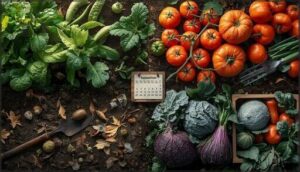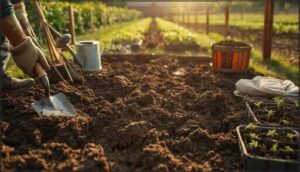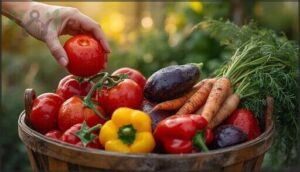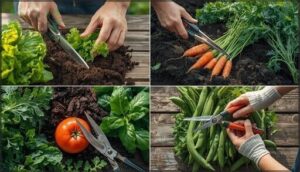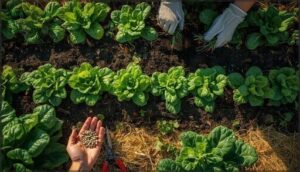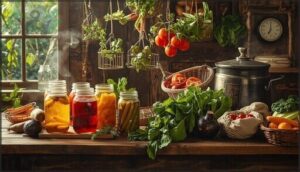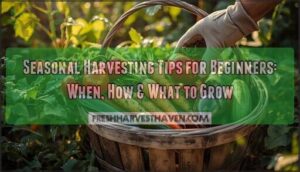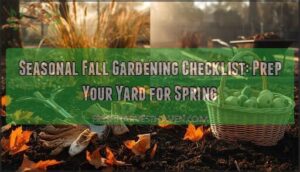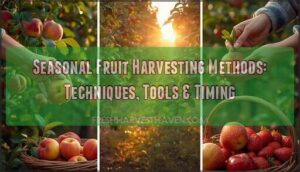This site is supported by our readers. We may earn a commission, at no cost to you, if you purchase through links.
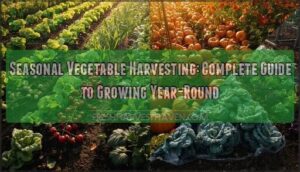
Seasonal vegetable harvesting isn’t about following a static calendar anymore. It’s about reading your local climate signals, matching crops to temperature windows, and timing plantings so harvests align with peak flavor and market demand. Understanding frost dates, hardiness zones, and varietal heat requirements turns guesswork into predictable yields.
Whether you’re planning cool-season greens for early spring or pushing warm-season tomatoes into late fall, success depends on selecting the right vegetables for your specific seasonal window and preparing your garden to support them.
Table Of Contents
Key Takeaways
- The U.S. growing season has extended nearly 12 days over the past century (spring frost seven days earlier, fall frost five days later), fundamentally changing what you can grow and when you can harvest it.
- Success in seasonal vegetable harvesting depends on matching crops to your specific USDA hardiness zone, local frost dates, and heat accumulation patterns rather than following a static calendar.
- Cool-season crops like kale, spinach, and radishes tolerate hard freezes and can be succession-planted in fall, while season-extension tools like cold frames and row covers push harvest windows well beyond first frost.
- Proper harvest timing—recognizing maturity signs like color depth, texture, and aroma—combined with strategic post-harvest care like crop rotation and soil feeding maintains plant productivity throughout the growing season.
What is Seasonal Vegetable Harvesting?
Seasonal vegetable harvesting means growing crops that match your local climate and time of year. Understanding how seasonal cycles, cultural traditions, and growing conditions work together helps you plan a productive garden year-round.
The term “seasonal” has roots going back to 1838, describing activities that vary with the seasons.
Definition and Etymology of Seasonal
The word “seasonal” traces back to 1838, describing anything that happens during or varies with a particular time of year. Its linguistic evolution reflects three key contexts:
- Agricultural cycles – planting and harvest times tied to weather patterns
- Economic patterns – employment and sales fluctuations throughout the year
- Cultural traditions – festivals and celebrations marking seasonal changes
Understanding this definition helps you plan your garden around nature’s rhythms.
Importance of Seasonal Cycles in Agriculture
Seasonal cycles drive every decision you’ll make in your garden. The U.S. growing season has stretched nearly 12 days over the past century—spring frost arrives seven days earlier, and fall frost comes five days later. These extended growing seasons give you more time to plant and harvest, but they also demand smart planning around climate adaptation and pest cycles.
Understanding seasonal variations helps you time planting windows, rotate crops effectively, and align harvests with market timing for agricultural products. The increase in temperatures means that there’s also more accumulated heat during the growing season.
| Seasonal Factor | Impact on Your Garden | Planning Strategy |
|---|---|---|
| Frost Dates | Determine safe planting windows | Plant after last spring frost, harvest before first fall frost |
| Heat Accumulation | Affects crop maturity and yield | Select varieties matched to your region’s thermal conditions |
| Regional Climate | Southwest gained 500°F heat over a century; Northeast saw similar increases | Adapt crop selection to local seasonal patterns |
| Crop Rotation | Prevents pest buildup and soil depletion | Rotate plant families based on seasonal cycles |
Cultural and Economic Impact of Seasonal Harvests
Your harvest connects you to deeper rhythms than you might realize. Over 70% of urban gardens in Los Angeles County grow crops tied to cultural traditions—mulberries for Armenian families, bitter melon for Southeast Asian communities.
Farmers markets generated $756,288 per market in Washington State during 2023’s peak season, while harvest festivals like Dollywood’s drew 50,000 daily visitors. The festival’s success highlights the appeal of Appalachian culture.
Seasonal farmworkers spend nearly all their wages locally, pumping $49.4 million into Virginia’s economy alone. When you choose seasonal produce and support local agricultural products, you’re preserving cultural foodways and strengthening regional economies through every bite.
Choosing seasonal produce preserves cultural foodways and strengthens regional economies through every bite
Seasonal Variations and Growing Conditions
Your crops won’t grow the same way in January as they do in July—and that’s exactly what makes seasonal gardening work. Cool temperatures shift hardiness zones and trigger first frost dates, affecting sunlight exposure and watering needs.
Regional soil composition and climate microzones determine your growing season length, while seasonal variations alter pest management strategies throughout the year.
Choosing Vegetables for Each Season
Picking the right vegetables for your climate and season makes all the difference between a thriving garden and a frustrating one. Your success depends on understanding hardiness zones, choosing crops that match your local conditions, and knowing which varieties tolerate cold weather best.
Let’s break down how to select vegetables that’ll actually grow well in your garden throughout the year.
USDA Hardiness Zones and Climate Considerations
Understanding your hardiness zone acts like a roadmap for planting success. The 2023 USDA zone map, drawn from over 13,000 weather stations, revealed that roughly half the country shifted to warmer half-zones. These climate-driven shifts mean your frost dates, growing season length, and suitable vegetable varieties have likely changed, affecting both what you can plant and your harvest periods.
- Zone identification determines which crops will thrive in your specific climate and guides garden planning decisions
- The map’s evolution reflects a 2.5°F warming trend, expanding options for warm-season vegetables in many regions
- Frost-free periods now stretch about seven days longer since 1985, allowing extended harvest intervals
- Localized zone precision helps you select vegetable varieties matched to your actual minimum winter temperatures
Fall and Winter Vegetable Selection
When cold weather arrives, choosing the right vegetable varieties makes all the difference. Cold-hardy varieties like spinach and kale survive heavy frosts and deliver nutritional benefits through winter months.
Regional adaptation matters—northern growers rely on storage potential from squash and onions, while fall planting of cool-season vegetables extends your harvest.
Smart planting strategies match frost-hardy winter vegetables to your climate, ensuring productive gardens year-round.
Leafy Greens Vs. Root Crops
When you’re planning your seasonal garden, the choice between leafy greens and root crops depends on how quickly you need results and how much space you can spare. Leafy greens like lettuce and kale mature faster, while root vegetables require deeper soil but offer better storage differences.
Consider nutrient comparison and pest resistance when selecting crops—greens prefer nitrogen-rich conditions, whereas root crops thrive in loosened, well-drained soil for best harvest.
Easy-to-Grow and Frost-Hardy Varieties
If you want crops that laugh at winter’s chill and practically grow themselves, frost-hardy varieties like kale, spinach, and garlic are your garden’s best insurance policy. These beginner vegetables tolerate hard freezes and require minimal fussing.
Cool-season vegetables like radishes and arugula deliver quick-growing results, often ready to harvest within weeks. Low-maintenance crops extend your vegetable gardening season without constant attention.
Preparing Your Garden for Planting
Getting your garden ready takes more than just clearing a spot and dropping seeds in the ground. You’ll need to think about soil health, timing, and whether you’re starting from seed or using transplants.
Here’s what you should focus on to set yourself up for success.
Soil Preparation and Fertility
Your garden’s soil acts as the foundation for everything you’ll grow, so getting it right now saves you headaches later. Start with soil testing to check nutrient balance and pH levels.
Work in organic amendments like compost to boost organic matter, which improves well-draining soil structure. Add composting methods or cover cropping before planting vegetables to build fertility naturally and support healthy root development through proper soil preparation for planting.
Starting Seeds Vs. Transplanting
Deciding between sowing seeds directly or buying transplants depends on your timeline, budget, and what you need to think about during the growing process. Here’s what to consider:
- Seed starting benefits include lower cost and wider variety selection
- Transplants skip germination but risk transplant shock during vegetable transplanting
- Root development stays stronger when vegetable seed planting happens in-place
- Timing considerations favor seedlings for late-season crops
- Cost analysis shows seeds win for large gardens
Indoor and Outdoor Planting Tips
Whether you’re nurturing seedlings under grow lights or tucking transplants into garden beds, understanding the conditions each space offers will help you match crops to their best environment. Indoor setups give you control over light requirements and watering techniques, while outdoor planting lets you work with microclimates in your vegetable garden.
Container selection matters for both spaces when growing cool-season vegetables. Pest control and garden tips vary depending on where you plant, so adjust your approach from planting through harvesting.
Extending The Growing Season
A few simple strategies can push your harvest window well beyond the first frost, letting you pull fresh vegetables from the garden when neighbors have already packed it in for winter.
Season extension tools protect cool-season vegetables during cold snaps:
- Cold frames trap solar heat and shield crops from wind
- Row covers add 4-8°F of frost protection over beds
- Greenhouse gardening extends harvest time by weeks or months
These methods keep your vegetable garden productive when temperatures drop.
When and How to Harvest Vegetables
Knowing when your vegetables are ready to pick—and how to harvest them properly—makes all the difference between a disappointing crop and one that keeps producing all season long.
The right technique protects your plants while maximizing yield, and proper storage ensures nothing goes to waste.
Here’s what you need to know about timing, technique, and preservation.
Signs of Vegetable Maturity
Knowing when your vegetables are ready to pick makes the difference between bland, underripe produce and the peak-flavor harvest you’ve been working toward all season. Visual maturity signs like color depth and size guide your harvest time. Check texture and firmness by gently squeezing vegetables.
Aroma indicators reveal ripeness in tomatoes and melons. Taste testing small samples confirms best harvest time. Your vegetable harvest guide should note days to maturity for accurate timing.
Harvesting Techniques for Different Crops
Each crop has its own preferred picking method, and using the right technique protects both the plant and the quality of your harvest. Proper vegetable harvesting techniques minimize damage and preserve freshness:
- Leafy greens: Cut outer leaves with scissors at maturity, leaving the plant base intact for continued growth
- Root vegetables: Loosen soil first, then pull gently to avoid breaking stems at harvest time
- Tomatoes and peppers: Twist or use pruning shears to prevent tearing delicate branches
- Beans and peas: Support the vine while harvesting to protect future production
Maintaining Plant Productivity After Harvest
Once you’ve picked your vegetables, don’t let the plant sit idle—strategic care after harvest keeps production going strong. Feed your soil with compost to replace lost nutrients, rotate crops to prevent pest buildup, and remove spent foliage promptly.
You’ll maintain plant productivity through the season by monitoring for disease, mulching to retain moisture, and saving seeds from your best producers for next year’s planting.
Storing and Preserving Fresh Produce
After harvesting and storing vegetables, ideal temperature control becomes your first line of defense against spoilage. Keep your refrigerator at or below 41°F, ensuring most vegetables stay fresh at 45-50°F with 95% relative humidity.
Air circulation matters—store berries in vented containers and mushrooms in paper bags to prevent mold. Separate ethylene-producing fruits from sensitive crops like broccoli and cauliflower.
Preservation techniques like pickling, drying, and pressure canning extend your seasonal eating window well into winter, while sustainable technologies such as bio-protection coatings are emerging for commercial growers seeking longer shelf life.
Top 6 Products for Seasonal Harvest Success
Having the right supplies can make the difference between a struggling garden and a thriving one.
The following six products are proven tools that simplify planting and boost your chances of a successful seasonal harvest.
Each item meets a specific need in year-round vegetable production.
1. Fresh Purple Garlic Bulbs for Planting
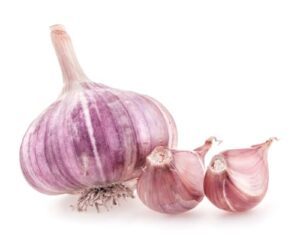
You’ll find that purple garlic bulbs from Greenhouse PCA offer a simple entry point into fall planting, especially throughout October when cool-season crops thrive. These non-GMO bulbs produce strong-flavored garlic that’s ready for midsummer harvesting, and each clove planted in well-drained soil generates a full bulb.
Purple varieties need positioning 1 to 3 inches deep and 6 inches apart, with proper garlic care including mulching to protect against winter cold.
Your vegetable planting guide should note that these bulbs adapt well across hardiness zones and reward you with gourmet ingredients for seasonal recipes.
Best For: Home gardeners who want to grow flavorful, chemical-free garlic in their fall gardens and don’t mind paying a premium for specialty bulbs.
- Strong, complex flavor with easier-to-peel purple cloves that work great in cooking or for replanting to expand your garden
- Simple growing process with excellent winter hardiness and reliable bulb production from each planted clove
- Non-GMO bulbs free of chemicals, giving you control over exactly what goes into your homegrown garlic
- Higher price point compared to standard garlic bulbs, which some buyers find steep for a small quantity
- Bulb size varies, and smaller bulbs may not produce the best results or yield as many cloves
- Not immune to purple blotch disease, requiring careful clove selection and proper mulching to prevent issues
2. Winter Gem Lettuce Seeds Heirlooms
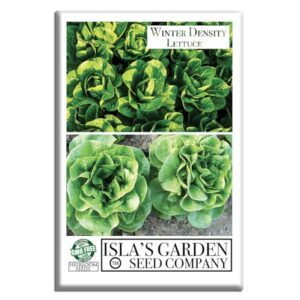
Winter Gem lettuce seeds give you a cool-season heirloom vegetable that bridges fall and spring harvests with exceptional climate adaptability. These compact romaine-butterhead crosses form dense 6-to-8-inch heads in just 45 to 50 days, tolerating both frost and summer heat without bolting.
You’ll plant seeds 1⁄4 inch deep, spacing mature plants 8 inches apart in well-drained soil. The variety’s disease resistance to downy mildew and strong culinary uses—crisp, sweet leaves perfect for salads—make it practical for containers or garden beds across hardiness zones 3 through 12.
Best For: Home gardeners in zones 3-12 who want year-round lettuce harvests with minimal fuss, especially those dealing with unpredictable weather or limited space.
- Exceptional cold tolerance survives hard freezes and germinates in soil as cool as 40°F, allowing fall-through-spring harvests
- Fast 45-50 day maturity with compact 6-8 inch heads perfect for containers and small gardens
- Natural disease resistance to downy mildew and lettuce mosaic virus reduces need for chemical treatments
- Some buyers report inconsistent germination rates or disappointing growth results
- Requires careful attention to spacing (8-12 inches) and consistent moisture to prevent bitter, stunted leaves
- Will bolt prematurely if not harvested on time or exposed to prolonged heat above 72°F
3. Indoor Herb Garden Starter Kit
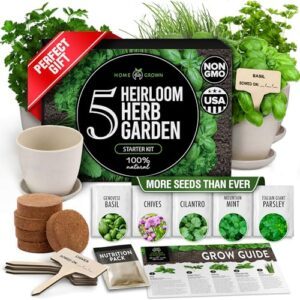
Your Indoor Herb Garden Starter Kit brings year-round herb production to kitchens without yard space, packaging five culinary varieties—basil, chives, cilantro, mint, and parsley—with reusable pots, soil, and growth instructions.
These kits solve the challenge of winter herb gardening through controlled indoor environments, achieving germination rates exceeding 85 percent within two weeks when you maintain consistent moisture.
You’ll find beginner-friendly features like labeled plant markers and hermetically sealed seeds that stay viable for two years, requiring just 10 to 15 minutes of weekly care for months of harvestable leaves.
Best For: Home cooks and beginner gardeners who want fresh herbs year-round without outdoor space or extensive gardening experience.
- Includes everything needed to start growing—five popular culinary herbs, reusable pots with trays, wooden markers, soil, and a detailed beginner’s guide
- Seeds stay fresh for up to two years in hermetically sealed packaging, and most varieties germinate within 7 to 14 days with proper care
- Low maintenance at just 10 to 15 minutes per week, fitting easily on countertops or windowsills in small apartments
- Some users report inconsistent germination despite following instructions, requiring patience and careful moisture management
- Components may feel smaller than expected, particularly the pots and soil quantity provided
- Lacks advanced features like LED grow lights or self-watering systems found in pricier kits, limiting placement options in low-light spaces
4. Live Dinosaur Kale Plants Tuscan
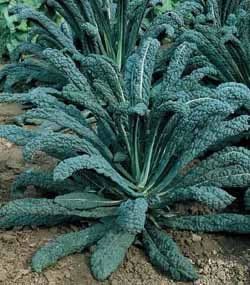 View On Amazon
View On Amazon Live Dinosaur Kale Plants from Clovers Garden skip seed germination delays, delivering two established 5-to-7-inch transplants with sturdy root systems for immediate fall planting in zones 7 through 12.
You’ll harvest dark blue-green leaves with distinctive bumpy texture within 30 days—much faster than direct-seeded crops—while tapping into outstanding kale nutrition: one cooked cup supplies over 450 percent of your daily vitamin K requirement.
These frost-hardy cool-season crops tolerate temperatures down to 20°F, making them ideal for vegetable gardening in fall when you need reliable leafy greens production, with proper harvest timing of outer leaves ensuring continuous yields through winter months.
Best For: Home gardeners in zones 7-12 who want to skip the wait and harvest nutrient-dense kale within a month of planting, especially those growing fall and winter crops.
- Two established plants with developed roots save you 30 days compared to starting from seed, letting you harvest leaves in about a month
- Incredibly nutritious—one cup of cooked kale delivers over 450% of your daily vitamin K plus significant calcium, iron, and antioxidants
- Cold-hardy down to 20°F and thrives in cool weather, making these plants perfect for reliable fall-through-winter harvests in temperate zones
- Limited to just two plants per order, so you’ll need multiple purchases for larger garden beds or family-sized harvests
- Requires consistent watering since kale has shallow roots and wilts quickly during dry spells
- Vulnerable to common pests like aphids and cabbage worms, though they’re usually manageable with manual removal or row covers
5. Black Spanish Radish Seeds for Planting
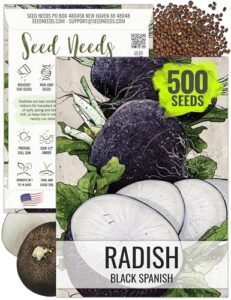
Black Spanish radish seeds deliver one of the boldest spicy radish flavor profiles in winter radish cultivation, maturing in 55 to 70 days after planting directly into fall garden beds. You’ll grow 3-to-4-inch black-skinned roots with crisp white flesh that stores for months in cool conditions, making them a cornerstone of winter vegetable gardening.
These heirloom radish benefits include excellent frost tolerance and compatibility with radish companion plants like lettuce and beets. Their drought resilience and extended storage distinguish black radishes from spring varieties in cool-season vegetables lineups.
Best For: Home gardeners seeking a cold-hardy, flavorful winter radish with excellent storage life and a bold, spicy kick for fall planting.
- Exceptional frost tolerance and 2–3 month storage capacity make them ideal for extending fresh harvests through winter
- Robust, spicy flavor that works raw or cooked, plus edible greens for dual-purpose harvesting
- Generous seed count (200–470 per packet) at $3.29 allows sharing, successive plantings, and multi-season use
- Some customers report inconsistent germination rates or slower-than-expected growth
- Strong, pungent flavor may not appeal to those preferring milder radish varieties
- Requires 55–70 days to maturity, longer than fast-growing spring radishes
6. Holland Red Shallots Bulbs for Planting
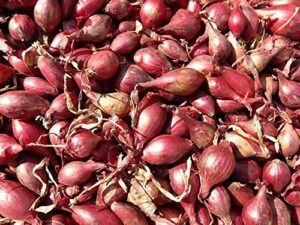
Holland Red shallots bulbs for planting multiply from single sets into clusters of 10 to 24 bulbs per harvest cycle, delivering up to 10 pounds of red shallots from just 1 pound planted.
You’ll plant these bulb varieties in fall or early spring, spacing them 3 to 6 inches apart in well-drained soil with a pH between 6.2 and 6.8. Soil preparation with compost boosts bulb size notably.
Harvest timing arrives when tops fall and skins show their signature reddish-copper color, usually after a full cool-season growing period. Proper storage extends shelf life to 8 months.
Best For: Home gardeners who want to grow their own culinary shallots with impressive multiplication rates and long-term storage potential.
- Each bulb multiplies into 10-24 new bulbs per harvest, giving you up to 10 pounds from just 1 pound planted
- Stores for 8-10 months when kept at proper temperature and humidity, providing fresh shallots year-round
- Adaptable planting schedule works for both fall and early spring, with harvest in 4-6 months
- Some customers report receiving sprouted, soft, or rotten bulbs that failed to grow
- Requires specific soil conditions (pH 6.2-6.8) and full sun for optimal yields
- Success depends heavily on proper spacing, fertilization, and ongoing pest management throughout the growing season
Frequently Asked Questions (FAQs)
How do you prevent pests during fall planting?
Don’t let pests bug your plans—use row covers, practice crop rotation, and apply neem oil to protect fall vegetables.
Remove garden debris, encourage beneficial insects, and plant resistant varieties to minimize pest pressure naturally.
What companion plants work best in October gardens?
In October gardening, companion planting pairs cool-season vegetables like broccoli with herbs such as dill and chamomile. Garlic deters pests when planted near lettuce.
Radishes break up soil for root crops, supporting fall harvesting success and effective crop rotation.
Can you succession plant vegetables in autumn months?
Yes, succession planting works brilliantly in autumn months. You can stagger sowings of fast-maturing crops like lettuce, radishes, and spinach every two to three weeks. This ensures continuous harvest throughout fall and early winter.
How much water do fall-planted crops need?
Fall-planted crops need less water than summer vegetables. Cool temperatures and shorter days slow evaporation and reduce plant transpiration.
You’ll usually water once or twice weekly, depending on rainfall and soil moisture levels. Check soil an inch deep before irrigating.
Which vegetables improve flavor after first frost?
Kale, Brussels sprouts, and parsnips develop sweeter flavors after frost exposure.
Cold hardy brassicas and winter roots convert starches to sugars when temperatures drop, naturally enhancing their taste through frost sweetened flavor development.
Conclusion
Your frost dates shape planting windows. Your hardiness zone determines crop selection. Your soil preparation sets yield potential. Each decision compounds into either scattered harvests or consistent production throughout the year.
Seasonal vegetable harvesting demands attention to these interconnected variables—not once, but every time you plan a succession planting or extend protection for cold-hardy greens.
The difference between hoping for results and engineering them comes down to matching biology to local climate signals, then acting on what the data tells you.
- https://docs.google.com/forms/d/1GAQr3Kn1cURCVHUA82hAga1Wv8DCH0IuqDLRUrOpN7M/viewform?ts=63f4f653&entry.1515682415=https://www.merriam-webster.com/dictionary%2Fseasonal
- https://premium.britannica.com/mw-unabridged/?utm_source=mw&utm_medium=inline-def&utm_campaign=evergreen
- https://it.thefreedictionary.com/stagionale
- https://ar.thefreedictionary.com/%d9%85%d9%8e%d9%88%d9%92%d8%b3%d9%90%d9%85%d9%90%d9%8a%d9%91
- https://de.thefreedictionary.com/saisonbedingt

